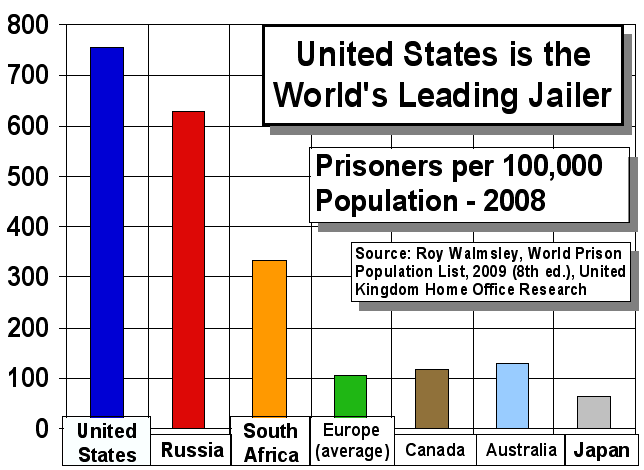Mass murders like the one involved in recent shootings in Arizona and California, when convicted would be housed in a super max prison. Four essential reasons for punishment include: retribution, deterrence, rehabilitation, and incapacitations such as isolation in order to prevent the criminals having contact with potential victims. In super max prisons, prisoners are mostly permitted out of their cells for only one hour a day; they are usually kept in solitary confinement. Prisoners receive their meals through ports in the doors of their cells. When exercise for super max jailbirds is acceptable it may take place in a small, enclosed area where the prisoner will exercise alone.
Prisoners are under continuous observation, usually with closed-circuit television cameras. Cell doors are usually opaque, while the cells may be windowless. Cell design may include a plain soundproofed room with metal furniture. Often cell walls, and sometimes plumbing, are soundproofed to prevent communication between the inmates.
 Super max and Security Housing Unit (SHU) prisons create controversy, because several claim that the living conditions in such facilities violate the United States Constitution, explicitly, the Eighth Amendment's prohibition against "cruel and unusual" punishments. In 1996, a United Nations team assigned to investigate torture described Security Housing Unit conditions as "inhuman and degrading".
Super max and Security Housing Unit (SHU) prisons create controversy, because several claim that the living conditions in such facilities violate the United States Constitution, explicitly, the Eighth Amendment's prohibition against "cruel and unusual" punishments. In 1996, a United Nations team assigned to investigate torture described Security Housing Unit conditions as "inhuman and degrading". Inhuman and degrading – cruel and unusual term used for prisoners, but what of the victims and their families? Wasn’t the punishment inflicted on them by these convicts cruel and unusual? MOTHERS OF MURDERED SONS/DAUGHTERS website cite the feeling, “There is no grief like losing a child, especially by homicide.” For parents, family and friends is a 24/7 sentence with no time off for good behavior, no shortened sentence. There are too many websites for children memorial like http://findmissingkids.com/murderedchildren.html. There are too many wives without husbands and husbands without wives.
The punishment should fit the crime. Murders should be made to recite the names of their victims daily. They should have to give perpetual care to the graves. They should be made to pay for the funeral. The advancement of civilization has caused a change in the theory and in the method of punishment. In primitive society punishment was left to the individuals wronged or their families, and was vindictive or retributive: in quantity and quality it would bear no special relation to the character or gravity of the offense. Discipline & Punish: The Birth of the Prison
 The first world highly educated and developed United States has the highest documented incarceration rate in the world at 754 persons in prison or jail per 100,000 U.S. residents as of 2008. That’s more than the underdeveloped third world countries. A report released Feb. 28, 2008 indicates that more than 1 in 100 adults in the United States are in prison. The United States has less than 5% of the world's population and 23.4% of the world's prison population.
The first world highly educated and developed United States has the highest documented incarceration rate in the world at 754 persons in prison or jail per 100,000 U.S. residents as of 2008. That’s more than the underdeveloped third world countries. A report released Feb. 28, 2008 indicates that more than 1 in 100 adults in the United States are in prison. The United States has less than 5% of the world's population and 23.4% of the world's prison population. Are US prisons too comfortable? If only selected of the circumstances inherent in punishment are present, it is generally not regarded as a situation in which it would be precise to use the word "punishment". The Crisis of Imprisonment: Protest, Politics, and the Making of the American Penal State, 1776-1941 (Cambridge Historical Studies in American Law and Society)
Resources:
US & World Population Clock. U.S. Census Bureau.
Arizona Inmates Back on the Net. Wired News. 2002. Retrieved 2008-01-26.
Prisoners’ Rights – Legal Correspondence. FindLaw. Retrieved 2008-01-26.
Aging inmates clogging nation's prisons. Associated Press. September 30, 2007
Aday, Ronald H. (2003). Aging Prisoners: Crisis in American Corrections. Praeger. ISBN 0275971236
One in 100: Behind Bars in America 2008. Released Feb. 28, 2008. The Pew Center on the States.
Prisoners in 2008. (NCJ 228417). December 2009 report from the U.S. Bureau of Justice Statistics. By William J. Sabol, Ph.D. and Heather C. West, Ph.D., BJS Statisticians. Also, Matthew Cooper, BJS Intern. Table 9 on page 8 of the PDF file has the number of inmates in state or federal public prison facilities, local jails, U.S. territories, military facilities, U.S. Immigration and Customs Enforcement (ICE) owned and contracted facilities, jails in Indian country, and juvenile facilities. Table 8 on page 8 has the incarceration rates for 2000, 2007, and 2008.

No comments:
Post a Comment